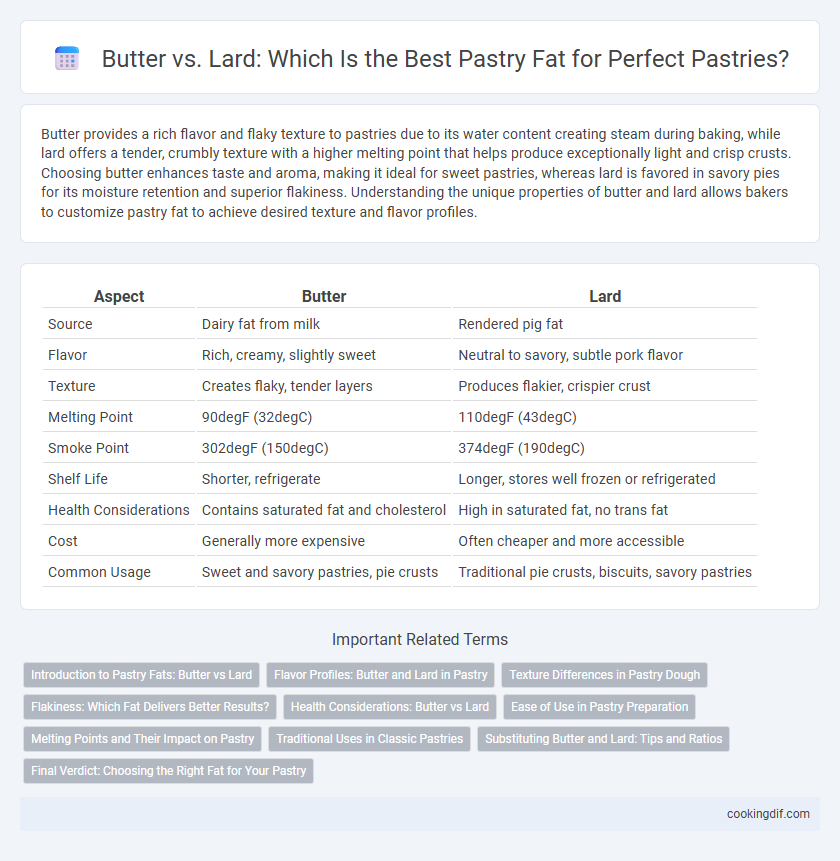Butter provides a rich flavor and flaky texture to pastries due to its water content creating steam during baking, while lard offers a tender, crumbly texture with a higher melting point that helps produce exceptionally light and crisp crusts. Choosing butter enhances taste and aroma, making it ideal for sweet pastries, whereas lard is favored in savory pies for its moisture retention and superior flakiness. Understanding the unique properties of butter and lard allows bakers to customize pastry fat to achieve desired texture and flavor profiles.
Table of Comparison
| Aspect | Butter | Lard |
|---|---|---|
| Source | Dairy fat from milk | Rendered pig fat |
| Flavor | Rich, creamy, slightly sweet | Neutral to savory, subtle pork flavor |
| Texture | Creates flaky, tender layers | Produces flakier, crispier crust |
| Melting Point | 90degF (32degC) | 110degF (43degC) |
| Smoke Point | 302degF (150degC) | 374degF (190degC) |
| Shelf Life | Shorter, refrigerate | Longer, stores well frozen or refrigerated |
| Health Considerations | Contains saturated fat and cholesterol | High in saturated fat, no trans fat |
| Cost | Generally more expensive | Often cheaper and more accessible |
| Common Usage | Sweet and savory pastries, pie crusts | Traditional pie crusts, biscuits, savory pastries |
Introduction to Pastry Fats: Butter vs Lard
Butter and lard are the two primary fats used in pastry making, each imparting distinct textures and flavors. Butter, with its water content and milk solids, creates a flaky, tender crust rich in flavor, while lard, being 100% fat, produces a exceptionally flaky and crisp pastry due to its larger fat crystals. Choosing between butter and lard depends on the desired balance between flavor intensity and pastry flakiness in bakery products.
Flavor Profiles: Butter and Lard in Pastry
Butter imparts a rich, creamy flavor with subtle sweetness, enhancing the overall taste and aroma of pastries. Lard provides a more neutral, savory profile with a slightly meaty undertone, contributing to flakiness without overpowering other ingredients. The choice between butter and lard significantly influences the flavor depth and texture of the pastry crust.
Texture Differences in Pastry Dough
Butter creates a flaky, tender pastry dough due to its high water content, which produces steam during baking and distinct layers. Lard yields a crumbly, tender texture with less flakiness because of its pure fat composition and larger fat crystals. Choosing between butter and lard directly impacts the pastry's mouthfeel and structural integrity.
Flakiness: Which Fat Delivers Better Results?
Butter and lard both contribute to flakiness in pastry, but lard typically produces a flakier texture due to its larger fat crystals and higher melting point. Butter offers rich flavor but contains more water, which can create steam and slightly affect flakiness. For optimal flaky layers, many bakers prefer lard or a combination of butter and lard to balance flavor and texture.
Health Considerations: Butter vs Lard
Butter contains saturated fats and cholesterol that may contribute to heart disease, whereas lard is higher in monounsaturated fats, which can promote better heart health. Butter also provides vitamins A and D, while lard offers less in terms of micronutrients but contains fewer trans fats than some processed fats. Choosing between butter and lard depends on individual dietary needs, with lard often considered a better option for those seeking healthier fat profiles in pastry making.
Ease of Use in Pastry Preparation
Butter offers superior ease of use in pastry preparation due to its consistent texture and ability to blend smoothly into dough, enhancing plasticity and workability. Lard, while traditional in some recipes, can be harder to handle because of its firmer structure and tendency to melt quickly at room temperature, making precise layering and dough manipulation more challenging. Choosing butter simplifies the process, especially for beginners, by facilitating even incorporation and reducing the risk of overworking the dough.
Melting Points and Their Impact on Pastry
Butter has a melting point of approximately 90-95degF (32-35degC), which allows it to melt quickly in the oven, creating steam that contributes to flaky and tender pastry layers. Lard melts at a higher temperature, around 100-113degF (38-45degC), resulting in a slightly firmer texture and a more pronounced flakiness due to slower melting. The difference in melting points directly affects the pastry's crumb structure, with butter providing a richer flavor and lard contributing to a flakier, crispier finish.
Traditional Uses in Classic Pastries
Butter and lard have distinct traditional uses in classic pastries, with butter prized for its rich flavor and tender texture in French puff pastry and croissants. Lard is favored in traditional savory pastries, such as British pork pies and Mexican empanadas, for yielding a flaky and robust crust. Both fats contribute unique qualities that influence the pastry's final taste, texture, and authenticity.
Substituting Butter and Lard: Tips and Ratios
When substituting butter for lard in pastry, use a 1:1 ratio to maintain similar fat content and texture, though butter adds a richer flavor due to its milk solids. Replacing butter with lard requires slightly less fat, approximately 0.8:1, as lard has a higher fat content and produces flakier crusts with a lighter mouthfeel. For best results, chill the fat thoroughly and handle dough minimally to preserve pastry tenderness regardless of the fat used.
Final Verdict: Choosing the Right Fat for Your Pastry
Butter offers a rich flavor and flaky texture ideal for pastries, while lard provides superior tenderness and crispiness. For sweet pastries, butter's creamy profile enhances taste, whereas lard excels in savory or ultra-flaky crusts due to its higher fat content and melting point. Selecting the right fat depends on desired texture and flavor, with butter favored for richness and lard preferred for maximum flakiness.
Butter vs Lard for pastry fat Infographic

 cookingdif.com
cookingdif.com